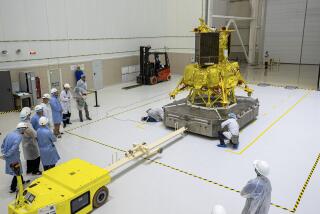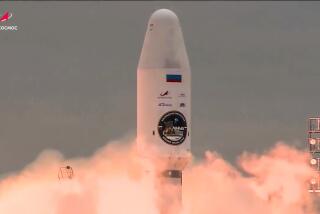TECHNOLOGY : Setting Sail for the Moon
- Share via
KALININGRAD, Russia — The Russian Federation is ahead of the pack in designing a futuristic spaceship that will be propelled through the cosmos by tiny particles bouncing off the craft’s reflective “sail.”
Scientific teams in the United States, Japan and Europe are all trying to develop such solar-sail spacecraft and are planning a four-way race to the moon as soon as they are ready.
But the Russian team, the last to declare its intention to enter the competition, has a healthy lead.
If all goes as planned, a test craft designed by leading Russian scientists will be launched in October of next year, according to Vladimir S. Syromyatnikov, a leading scientist from NPO Energia, the Russian company designing the craft.
The experimental craft will be equipped with a circular sail about 25 yards in diameter constructed of a super-thin polyester material called Mylar and should be able to fly for three days.
A larger version of the craft, with a sail about 200 yards in diameter, will be entered in the race to the moon, Syromyatnikov told reporters in this Moscow suburb, where many of the space institutes are based.
The final version, made with a more advanced material, would need a much longer life to be able to make it to the moon, a trip the Russian scientists predict will take a few months but that the international competitors say will take about a year.
The big race to the moon has been postponed several times because of financial restraints on all the research teams, none of which are government-sponsored. The latest estimates are that the race will begin sometime in 1994.
Standing on a stage with a backdrop of the shiny silver “sail” to be used in the first experimental flight, Syromyatnikov looked a little like a used-car salesman, and with good reason.
For the first time, Russian space pioneers are faced with the challenge of raising money to develop their space program, and they have come up with the gimmick of using the circular sail as a kind of billboard, selling off “pie slices” for company advertisements.
Although selling advertising was not a part of his job when he designed the coupling mechanism for the historic Apollo-Soyuz flight in 1976, Syromyatnikov indicated that he is ready to do what it takes to get his solar sail craft into the cosmos.
“Everybody needs money in order to develop their sail craft,” he said with a shrug. “I understand our French friends are in the same boat.”
Money seems to be the only thing that has kept solar-sail craft from becoming a reality. Scientists have long believed that such designs could be practical, but there has been little money for development.
“Everybody’s pretty sure it will work,” said James J. Harford, executive director emeritus of the American Institute of Aeronautics and Astronautics. “But seeing it in space will be another thing.”
Theoretically, the sail craft are propelled through space by tiny solar particles called photons. Light travels from the sun in photons, which impart a small amount of energy whenever they strike a solid object.
Scientists believe that a large reflective surface could be driven faster and faster by the photons if its mass were light enough. So if a sail made of extremely strong, lightweight material is put into orbit and controlled from the ground, it could be angled so that it would pick up speed as the photons bounce off its surface.
“I believe it is going to show that solar energy can propel a vehicle through space,” said Harford, who was involved in space technology for 37 years. “In my experience, a lot of interesting projects were started up by determined people being ignored by their bosses. This one has as much chance as a lot of the projects that seemed wacky at the start--such as launching Sputnik in 1957.”
More to Read
Sign up for Essential California
The most important California stories and recommendations in your inbox every morning.
You may occasionally receive promotional content from the Los Angeles Times.













